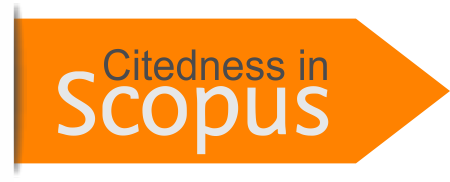Fuzzy Time Series Application in Predicting the Number of Confirmation Cases of Covid-19 Patients in Indonesia
Abstract
Forecasting is a statistical method that can use historical data patterns to predict future events. This article discusses the prediction of the number of new confirmed cases of Covid-19 patients in Indonesia. The data used is from January 1, 2021 to August 7, 2021. The methods used are Fuzzy Time Series (FTS) Chen (2014) and Cheng et al. (2008). FTS is a forecasting method that uses rules and logic on fuzzy sets. The level of prediction accuracy is then calculated based on the Mean Absolute Percentage Error (MAPE) value. The MAPE values of these two methods are then compared to know which method is more suitable in this case study. The results showed that FTS Chen produced an accuracy of 12.75% and FTS Cheng produced an accuracy of 14.27%. The results of this study indicate that FTS Chen and FTS Cheng produce good accuracy and can be used to predict new confirmed cases of Covid 19 sufferers in Indonesia.
Keywords
Full Text:
PDFReferences
Aditantri, R., Mahliza, F., & Wibisono, A. D. (2021). Urban Planning and E-Commerce: Understanding the Impact During Pandemic Covid-19 in Jakarta. International Journal of Business, Economics, and Social Development, 2(3), 135-142.
Anastassopoulou, C., Russo, L., Tsakris, A., & Siettos, C. (2020). Data-based analysis, modelling and forecasting of the COVID-19 outbreak. PloS one, 15(3), e0230405.
Andriyani, D., Nailufar, F., Yurina, Y., Ratna, R., & Rahmah, M. (2021). Analyzing the Sustainability of Micro, Small and Medium Enterprises during Covid-19 Pandemic in Bireuen Regency, Indonesia. International Journal of Business, Economics, and Social Development, 2(3), 119-126.
Bastos, S. B., & Cajueiro, D. O. (2020). Modeling and forecasting the early evolution of the Covid-19 pandemic in Brazil. Scientific Reports, 10(1), 1-10.
Castillo, O., & Melin, P. (2020). Forecasting of COVID-19 time series for countries in the world based on a hybrid approach combining the fractal dimension and fuzzy logic. Chaos, Solitons & Fractals, 140, 110242.
Chen, S. M. (1996). Forecasting enrollments based on fuzzy time series. Fuzzy sets and systems, 81(3), 311-319.
Chen, M. Y. (2014). A high-order fuzzy time series forecasting model for internet stock trading. Future Generation Computer Systems, 37, 461-467.
Cheng, C. H., Wang, J. W., & Li, C. H. (2008). Forecasting the number of outpatient visits using a new fuzzy time series based on weighted-transitional matrix. Expert Systems with Applications, 34(4), 2568-2575.
Hadjira, A., Salhi, H., & El Hafa, F. (2021). A Comparative Study between ARIMA Model, Holt-Winters–No Seasonal and Fuzzy Time Series for New Cases of COVID-19 in Algeria. American Journal of Public Health, 9(6), 248-256.
Kumar, A., & Kaur, K. (2021, February). A hybrid SOM-Fuzzy time series (SOMFTS) technique for future forecasting of COVID-19 cases and MCDM based evaluation of COVID-19 forecasting models. In 2021 International Conference on Computing, Communication, and Intelligent Systems (ICCCIS) (pp. 612-617).
IEEE. Kumar, N., & Kumar, H. (2021). A novel hybrid fuzzy time series model for prediction of COVID-19 infected cases and deaths in India. ISA transactions. In Press
Kumar, N., & Susan, S. (2021). Particle swarm optimization of partitions and fuzzy order for fuzzy time series forecasting of COVID-19. Applied Soft Computing, 107611.
Li, Q., Feng, W., & Quan, Y. H. (2020). Trend and forecasting of the COVID-19 outbreak in China. Journal of Infection, 80(4), 469-496.
Mishra, P., Fatih, C., Rawat, D., Sahu, S., Pandey, S. A., Ray, M., ... & Sanusi, O. M. (2020). Trajectory of COVID-19 Data in India: Investigation and Project Using Artificial Neural Network, Fuzzy Time Series and ARIMA Models. Annual Research & Review in Biology, 46-54.
Munandar, D., Supian, S., & Subiyanto, S. (2020). Probability distributions of COVID-19 tweet posted trends uses a nonhomogeneous Poisson process. International Journal of Quantitative Research and Modeling, 1(4), 229-238.
Novika, F., & Meliyani, R. (2021). Procrustes Analysis of Indonesian Mortality Table Iv and Indonesia's Death Rate During Covid-19 Pandemic. International Journal of Quantitative Research and Modeling, 2(2), 91-96.
Olivia, S., Gibson, J., & Nasrudin, R. A. (2020). Indonesia in the Time of Covid-19. Bulletin of Indonesian Economic Studies, 56(2), 143-174.
Sarkar, K., Khajanchi, S., & Nieto, J. J. (2020). Modeling and forecasting the COVID-19 pandemic in India. Chaos, Solitons & Fractals, 139, 110049.
Sukono, Sambas, A., He, S., Liu, H., Vaidyanathan, S., Hidayat, Y., & Saputra, J. (2020). Dynamical analysis and adaptive fuzzy control for the fractional-order financial risk chaotic system. Advances in Difference Equations, 674(1), 1-12.
Suyatna, N. (2021). The Effect of Stimulus Policies and Risk-Based Capital Levels on Solvency at PT. Indonesian Takaful using Sharia Principles during the Majeur Force Period (Covid-19 Pandemic) in Indonesia. International Journal of Business, Economics, and Social Development, 2(1), 24-31.
Tosepu, R., Gunawan, J., Effendy, D. S., Lestari, H., Bahar, H., & Asfian, P. (2020). Correlation between weather and Covid-19 pandemic in Jakarta, Indonesia. Science of the total environment, 725, 138436.
Xian, S., & Cheng, Y. (2021). Pythagorean fuzzy time series model based on Pythagorean fuzzy c-means and improved Markov weighted in the prediction of the new COVID-19 cases. Soft Computing, 25(22), 13881-13896.
Zeroual, A., Harrou, F., Dairi, A., & Sun, Y. (2020). Deep learning methods for forecasting COVID-19 time-Series data: A Comparative study. Chaos, Solitons & Fractals, 140, 110121.
Zhang, H., Song, H., Wen, L., & Liu, C. (2021). Forecasting tourism recovery amid COVID-19. Annals of Tourism Research, 87, 103149.
DOI: https://doi.org/10.46336/ijqrm.v2i4.194
Refbacks
- There are currently no refbacks.
Copyright (c) 2021 Lintang Patria

This work is licensed under a Creative Commons Attribution 4.0 International License.
Published By:
IJQRM: Jalan Riung Ampuh No. 3, Riung Bandung, Kota Bandung 40295, Jawa Barat, Indonesia
IJQRM Indexed By:
 Creation is distributed below Lisensi Creative Commons Atribusi 4.0 Internasional.
Creation is distributed below Lisensi Creative Commons Atribusi 4.0 Internasional.








